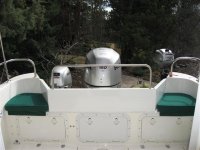Captains Cat":17ssj6no said:
"self bailing" means that the cockpit floor is above the waterline and any water in there, runs out by gravity through the scuppers. The TC255 is the same way, unlike the CD 22 which has a deep cockpit, bottom below the waterline and bilge pump(s).
Charlie
This is all true, but I wonder if a cockpit were really fully dumped ("pooped") on and pretty full, if it would ever self-bail in really heavy seas once the transom was very low in the water, and the waves were able to come in at will?
Certainly, in calm conditions and when the water taken on is limited, the self-bailing feature will work, and does, but what about the above?
Certainly, keep the cockpit door and windows secured to maintain that part of the flotation.
What is the center of gravity and the flotation stability once the cockpit is heavily flooded? (There's some limited knowledge from a CD-25's demise in Alaska where the stern was flooded due to a line caught and tied to the stern, if I remember right. Was it an anchor line caught in the prop? If so, that would be a little different situation, being tied down astern.)
Will the boat remain upright or roll over with wave pressure?
We do know from previous discussions that once the cabin is flooded, the boats will roll over with only the underside of the bow/forward section of the hull remaining above water.
Hopefully the above will not happen and certainly it has been a rare occurance, but I've got a suspicion there is a POINT OF NO RETURN with too much water in the cockpit, the "self bailing" feature not withstanding. The bilge pump(s) functioning would be a moot point in such a flooding.
We had such a self-bailing feature on small racing dinghy sailboats, but there were buoyancy tanks along and inside the gunnels (or a significantly large double bottom) to render the boat very buoyant and unsinkable, like a surfboard, more or less.
I'm not trying to be an alarmist here, just point out that there probably is a limit to this feature in a C-Dory, IMHO.
Joe. :teeth :thup

